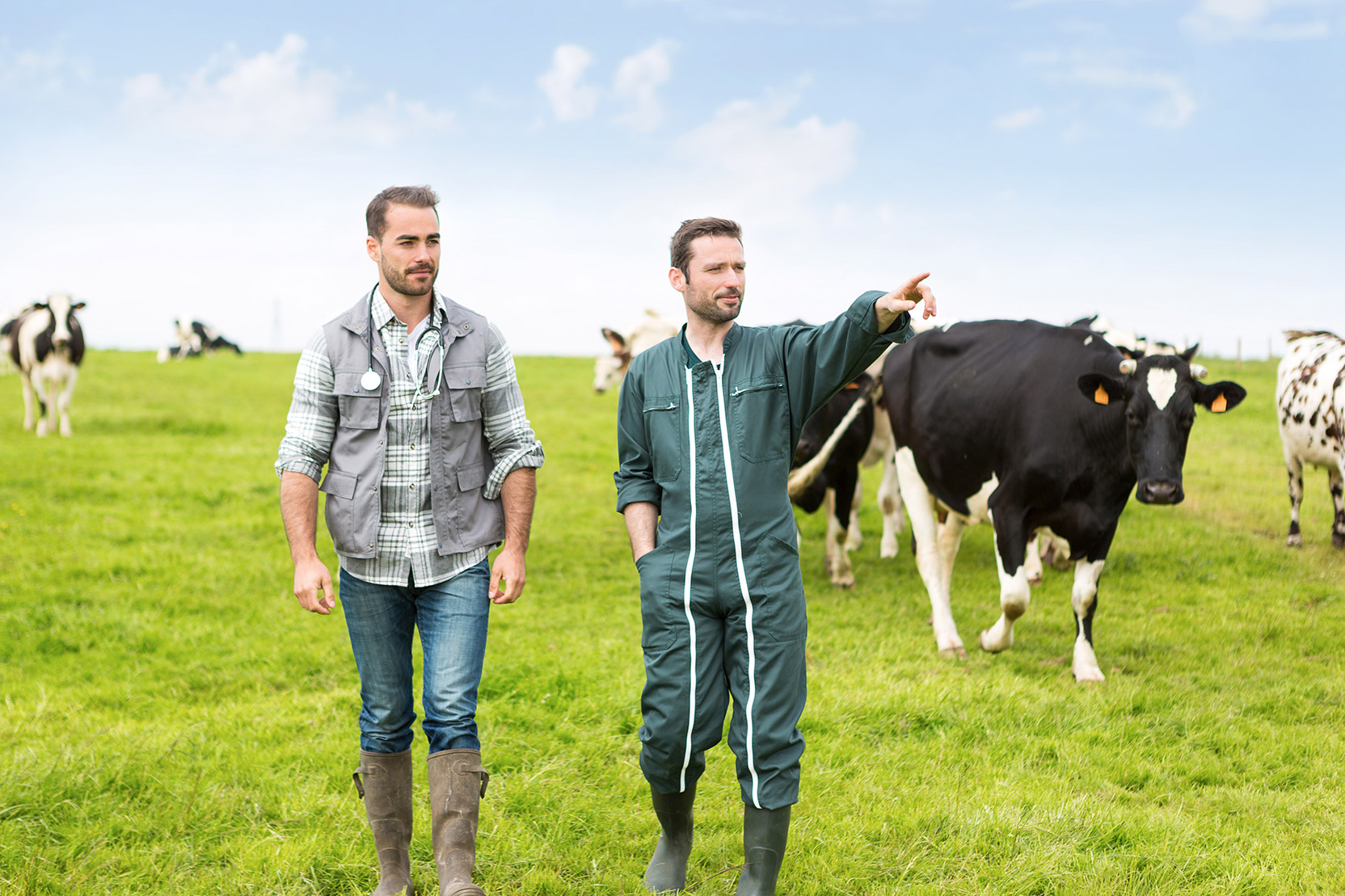4 Leadership & managing relationships
Successful practice management relies a great deal on leadership. This is the same when adding and managing O/A services in your practice. Whether you are an associate, director, or practice owner, attention to and application of various leadership styles and techniques is necessary for veterinary medicine. Veterinarians are leaders of their teams, animal health and wellness, and much more. This section will highlight leadership areas to help build and manage O/A services in your practice.
These chapters on O/A continuing education provide a solid foundation of O/A knowledge for you to practice and implement into your veterinary services. Now you must consider how to share what you have learned with your staff and your clients.

Veterinary technicians on O/A farms
Veterinary Technicians have many roles, both inside and outside of the clinic. Vet techs often travel with veterinarians to farms and ranches in mixed and large animal rural practices. They provide useful skills and support to veterinarians and clients. Skillful vet techs offer a second set of eyes for the veterinarian. The vet tech’s role includes giving drugs and vaccines, collecting samples, assisting in field surgery, and explaining procedures, including disease prevention actions such as cleaning and disinfection. The skill set that vet techs bring to O/A farms and ranches is no different. On O/A farms, vet techs can bring new skills and knowledge to assist veterinarians and help producers manage and care for their organic and alternative livestock. Additional information and resources for working with veterinary technicians can be found at:
- AgHires-Veterinary Technician
- Becoming a veterinary technician
- Veterinary Technicians and the Large Animal Ranching Sector
Extension services on O/A farms
Agricultural Extension, a part of the state’s Land-Grant University, is a method for non-formal education and practical application of science on farms. Extension agents and specialists help producers assess their needs and have resources and programs that farms can use to fit them. Extension provides resources to increase production in addition to safety classes, youth development, nutrition education, and mental health resources. These resources are important and provide for farmers’ welfare and personal development and help build future generations of farmers. O/A farming is a prospect for growth for extension programs (Alotaibi et al., 2021). O/A knowledgeable extension agents can help connect valuable practices and applicable research with farmers and ranchers needing assistance and increase the benefit to those they serve. Additional information and resources for working with extension services can be found at:
- Organic Livestock Systems: Views of Veterinarians and Organic Producers
- NIFA-Extension
- Chapter 1: Overview & Importance of Agricultural Extension
- Perception of organic farmers toward organic agriculture and role of extension
Leadership skills for working with staff and clients
You may feel comfortable contacting O/A clients, providing alternative therapies, etc. However, the groups you are working with may feel differently or not be on the same page. You may already offer O/A services and work with O/A clients, or you may want to add them to your practice after taking this course. Wherever you are in this journey, you and your practice will likely experience change. This may be by offering entirely new services, adapting existing client informational handouts to include O/A, or educating staff on O/A requirements. However, while change can be a very positive thing, change is commonly resisted by staff and clients. Common reasons for this are fear, timing, loss of control, lack of reward, and prior negative experience with change. The following leadership tips and discussion of leadership styles will help you navigate change with your staff and clients.
Successfully managing and leading a veterinary practice or team requires emotional intelligence. Defined as the ability to identify and manage ourselves and our relationships, emotional intelligence is a skill that can be developed and improved upon over time. It relates to how one can successfully navigate intrapersonal and interpersonal emotions and behaviors. The awareness, management, and regulation of empathy, motivation, and social skills influence understanding and communication of oneself and others. Leaders with higher emotional intelligence, meaning a higher aptitude for understanding and incorporating these described elements, are more likely to achieve successful outcomes with their teams and in their relationships. In addition, these skills facilitate working through change. This change could be getting your staff on board with offering services to O/A clients or working with an O/A farmer who wants to add a vaccine protocol to their standard operating procedures. One must consider self-awareness, self-management, social awareness, and social skills to work on emotional intelligence. A leader’s growth in these areas is important because they influence the workplace and social environments. These environments are the foundation for a team or relationship to navigate, adapt and grow. The personal capabilities mentioned in this section are expanded upon in Goleman’s texts and linked at the end of this section.
Emotional intelligence is typically broken down into four core competencies:
- Self-awareness
- Self-management
- Social awareness
- Relationship management
According to psychologists and researchers, the workplace and social environment are impacted by six key factors or drivers:
- their flexibility—that is, how free people feel to innovate unencumbered by red tape
- their sense of responsibility to the organization
- the level of standards that people set
- the sense of accuracy about performance feedback and aptness of rewards
- the clarity people have about mission and values
- the level of commitment to a common purpose
The emotional intelligence and leadership style of an entity’s leader influences these factors and the surrounding environment of the team and its relationships. In other words, leadership styles impact the factors or drivers of the workplace environment. Why is this particularly important for you? As someone taking this course in O/A veterinary medicine, you are at some stage of considering or implementing O/A services in your practice and will likely need to lead others in doing so as well. These other individuals or groups may be your staff, or they may be your clients. Regardless, the factors highlighted above affect the productivity and satisfaction of all involved.
We will now delve into leadership styles that incorporate these factors differently. As we go through them, think about how you can apply these styles in your practice and with your clients to improve outcomes in the respective working environments. For this chapter, we will be utilizing Goleman’s six leadership styles. He describes these styles and situations in which one may be preferred. He also reports that leaders with multiple leadership styles are more likely to have successful organizational outcomes. The degree to which an emotional intelligence competency or key environmental factor is used varies between the styles. Employing multiple styles is likely to lead to a more successful practice.
| Leadership Style |  Coercive Coercive |
 Authoritative Authoritative |
 Affiliative Affiliative |
 Democratic Democratic |
 Pacesetting Pacesetting |
 Coaching Coaching |
|---|---|---|---|---|---|---|
| Leader’s modus operandi | Demands immediate compliance | Mobilizes people toward a vision | Creates harmony and builds emotional bonds | Forges consensus through participation | Sets high standards for performance | Develops people for the future |
| Style in a phrase | “Do what I tell you.” | “Come with me.” | “People come first” | “What do you think?” | “Do as I do, now.” | “Try this.” |
| Underlying emotional intelligence competencies | Drive to achieve, initiative, self-control | Self-confidence, empathy, change catalyst | Empathy, building relationships, communication | Collaboration, team leadership, communication | Conscientiousness, drive to achieve, initiative | Developing others, empathy, self-awareness |
| When the style works best | In a crisis, to kick start a turnaround, or with problem employees | When change requires a new vision, or when a clear direction is needed | To heal rifts in a team or to motivate people during stressful circumstances | To build buy-in or consensus, or to get input from valuable employees | To get quick results from a highly motivated and competent team | To help an employee improve performance or develop long-term strengths |
| Overall impact on climate | Negative | Most strongly positive | Positive | Positive | Negative | Positive |
Printable handout of Goleman’s Leadership Styles at a Glance.
Remember that one style is not good or bad, but depending on the situation, a specific style may result in more effective outcomes. More in-depth information on these styles and effective leadership strategies can be found at:
- Goleman – Leadership That Gets Results
- Simon Sinek – How Great Leaders Inspire Action
- Goleman, Daniel, “Leadership that Gets Results” Harvard Business Review. March-April 2000 p. 82-82. ↵

